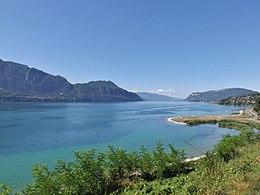
Back بحيرة دو بورجيه Arabic Лак-дзю-Буржэ Byelorussian Бурже (езеро) Bulgarian Lac du Bourget CEB Bourget Czech Лак-дю-Бурже CV Bourgetsøen Danish Lac du Bourget German Lago Bourget Esperanto Lago Bourget Spanish
| Lac du Bourget | |
|---|---|
 View from the heights of Viviers-du-Lac | |
| Location | Savoie, France |
| Coordinates | 45°44′N 5°52′E / 45.733°N 5.867°E |
| Primary inflows | Leysse, Tillet, Sierroz |
| Primary outflows | Canal de Savières, Rhône |
| Catchment area | 560 km2 (220 sq mi) |
| Basin countries | France |
| Max. length | 18 km (11 mi) |
| Max. width | 3.5 km (2.2 mi) |
| Surface area | 44.5 km2 (17.2 sq mi) |
| Average depth | 85 m (279 ft) |
| Max. depth | 145 m (476 ft) |
| Water volume | 3,600×106 m3 (2,900,000 acre⋅ft) |
| Residence time | 8 years |
| Surface elevation | 231.5 m (760 ft) |
| Settlements | Aix-les-Bains Le Bourget-du-Lac Brison-Saint-Innocent Conjux |
| Official name | Lac du Bourget - Marais de Chautagne |
| Designated | 2 February 2003 |
| Reference no. | 1268[1] |
Lac du Bourget (French: [lak dy buʁʒɛ]; English Lake Bourget), also locally known as Lac Gris ([lak gʁi]; English: Grey Lake) or Lac d'Aix ([lak d‿ɛ]), is a lake at the southernmost end of the Jura Mountains in the department of Savoie, France. It is the deepest lake located entirely within France, and either the largest or second largest after Lac de Grand-Lieu depending on season.[citation needed]
The largest town on its shore is Aix-les-Bains. Chambéry, the capital of Savoie, lies about 10 km south of the lake. The lake is mainly fed by the river Leysse (and other small rivers), and it drains towards the river Rhône through the Canal de Savières, an artificial channel. It is a Ramsar site. The extinct bezoule was found only in this lake.
The lake was formed during the last period of global glaciation in the Alps (Würm glaciation) during the Pleistocene epoch. It has a surface area of 44.5 square kilometres (4,450 hectares). The long and narrow north-south axis of the lake extends 18 km in length, and ranges between 1.6 km and 3.5 km in width.[2] The lake's average depth is 85 m, and its maximum depth in 145 m. The lake is meromictic. Unlike ordinary lakes, its deep water does not mix annually with water closer to the surface.[3]
The lake is bordered by the steep summits of the Mont du Chat and the Chaîne de l'Épine on the west, and Bauges Mountains on the east, which form its shores.
Lac du Bourget was made famous by several romantic poems of Alphonse de Lamartine, including Le Lac,[4] as well as by descriptions by Xavier de Maistre, Honoré de Balzac, and Alexandre Dumas.

- ^ "Lac du Bourget - Marais de Chautagne". Ramsar Sites Information Service. Retrieved 25 April 2018.
- ^ Agence Interactive. "Le lac du Bourget : activités, visites, nature, randonnées pédestres - Savoie Mont-Blanc (Savoie, Haute-Savoie, Alpes) - Savoie Mont Blanc (Savoie et Haute Savoie) - Alpes". Savoie-mont-blanc.com. Archived from the original on 29 October 2014. Retrieved 29 October 2014.
- ^ Cite error: The named reference
Jacquet2003was invoked but never defined (see the help page). - ^ "Poems Found in Translation, The Lake by Alphonse de Lamartine, translated by A.Z. Foreman". Poemstranslation.blogspot.com. Retrieved 29 October 2014.
© MMXXIII Rich X Search. We shall prevail. All rights reserved. Rich X Search
